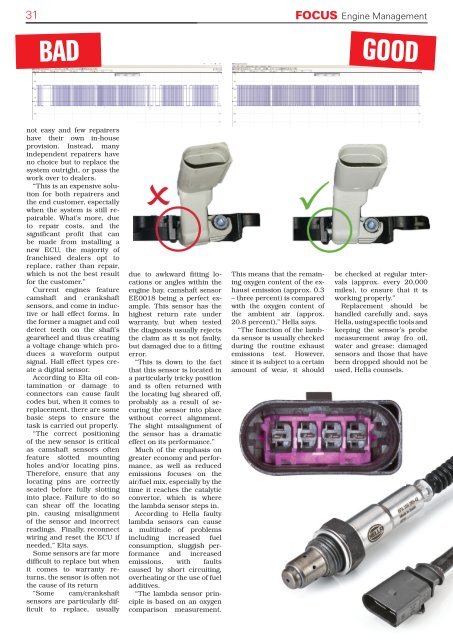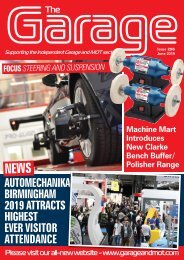The Garage 285
You also want an ePaper? Increase the reach of your titles
YUMPU automatically turns print PDFs into web optimized ePapers that Google loves.
31 focus Engine Management<br />
bad<br />
good<br />
not easy and few repairers<br />
have their own in-house<br />
provision. Instead, many<br />
independent repairers have<br />
no choice but to replace the<br />
system outright, or pass the<br />
work over to dealers.<br />
“This is an expensive solution<br />
for both repairers and<br />
the end customer, especially<br />
when the system is still repairable.<br />
What’s more, due<br />
to repair costs, and the<br />
significant profit that can<br />
be made from installing a<br />
new ECU, the majority of<br />
franchised dealers opt to<br />
replace, rather than repair,<br />
which is not the best result<br />
for the customer.”<br />
Current engines feature<br />
camshaft and crankshaft<br />
sensors, and come in inductive<br />
or hall effect forms. In<br />
the former a magnet and coil<br />
detect teeth on the shaft’s<br />
gearwheel and thus creating<br />
a voltage change which produces<br />
a waveform output<br />
signal. Hall effect types create<br />
a digital sensor.<br />
According to Elta oil contamination<br />
or damage to<br />
connectors can cause fault<br />
codes but, when it comes to<br />
replacement, there are some<br />
basic steps to ensure the<br />
task is carried out properly.<br />
“<strong>The</strong> correct positioning<br />
of the new sensor is critical<br />
as camshaft sensors often<br />
feature slotted mounting<br />
holes and/or locating pins.<br />
<strong>The</strong>refore, ensure that any<br />
locating pins are correctly<br />
seated before fully slotting<br />
into place. Failure to do so<br />
can shear off the locating<br />
pin, causing misalignment<br />
of the sensor and incorrect<br />
readings. Finally, reconnect<br />
wiring and reset the ECU if<br />
needed,” Elta says.<br />
Some sensors are far more<br />
difficult to replace but when<br />
it comes to warranty returns,<br />
the sensor is often not<br />
the cause of its return<br />
“Some cam/crankshaft<br />
sensors are particularly difficult<br />
to replace, usually<br />
due to awkward fitting locations<br />
or angles within the<br />
engine bay, camshaft sensor<br />
EE0018 being a perfect example.<br />
This sensor has the<br />
highest return rate under<br />
warranty, but when tested<br />
the diagnosis usually rejects<br />
the claim as it is not faulty,<br />
but damaged due to a fitting<br />
error.<br />
“This is down to the fact<br />
that this sensor is located in<br />
a particularly tricky position<br />
and is often returned with<br />
the locating lug sheared off,<br />
probably as a result of securing<br />
the sensor into place<br />
without correct alignment.<br />
<strong>The</strong> slight misalignment of<br />
the sensor has a dramatic<br />
effect on its performance.”<br />
Much of the emphasis on<br />
greater economy and performance,<br />
as well as reduced<br />
emissions focuses on the<br />
air/fuel mix, especially by the<br />
time it reaches the catalytic<br />
convertor, which is where<br />
the lambda sensor steps in.<br />
According to Hella faulty<br />
lambda sensors can cause<br />
a multitude of problems<br />
including increased fuel<br />
consumption, sluggish performance<br />
and increased<br />
emissions, with faults<br />
caused by short circuiting,<br />
overheating or the use of fuel<br />
additives.<br />
“<strong>The</strong> lambda sensor principle<br />
is based on an oxygen<br />
comparison measurement.<br />
This means that the remaining<br />
oxygen content of the exhaust<br />
emission (approx. 0.3<br />
– three percent) is compared<br />
with the oxygen content of<br />
the ambient air (approx.<br />
20.8 percent),” Hella says.<br />
“<strong>The</strong> function of the lambda<br />
sensor is usually checked<br />
during the routine exhaust<br />
emissions test. However,<br />
since it is subject to a certain<br />
amount of wear, it should<br />
be checked at regular intervals<br />
(approx. every 20,000<br />
miles), to ensure that it is<br />
working properly.”<br />
Replacement should be<br />
handled carefully and, says<br />
Hella, using specific tools and<br />
keeping the sensor’s probe<br />
measurement away fro oil,<br />
water and grease: damaged<br />
sensors and those that have<br />
been dropped should not be<br />
used, Hella counsels.<br />
30, 31 Engine Management.indd 2 13/11/2018 15:04

















